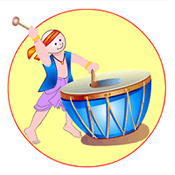
Dimdima
Online Children's Magazine from India

Dimdima
Online Children's Magazine from India

By Rani Iyer

As I watched the sunset on a hot evening a strange call perked me. "Ping….Ping….Ping," said a voice close by. Silence followed. As I was about to leave, "Did…did….did," it called. My curiosity was aroused. My search to locate the animal before sunset proved futile. I would have to come at daytime to study this, I decided.
One dawn as I was walking past the shallow pool, I saw a red tipped bird with bright yellow legs suddenly take wing, letting out soft cries that I heard previously. I froze to watch the antics. The bird kept a constant chatter with his partner hidden in the foliage of a low-branched tree. As I approached the tree in curiosity, the couple took to the air repeatedly crying, "did-he-do-it.
" Sure, I thought in shame, I did it! As I watched the bird I noticed that he was always near water. And if I got curious and approached him, he would let out an ear piercing alarm! This fascinating bird needed a closer study.
The water hole guardian is called the Red-Wattled lapwing (Lobivanellus indicus). They are found in tanks, ditches, puddles, cultivated areas, and in the open countryside. They are both crepuscular (active at dawn and dusk) and nocturnal in their activity. The bird has a black head, neck, throat and breast, which are enhanced by two snow-white stripes that run from the ear to under the wings. A crimson-red facial wattle on the face, yellow legs, and red beak add to the color. The name 'lapwing' is derived from its slightly irregular flight pattern, when there is a lag between wing beats.
When I discovered a nest on the ground, a shallow depression lined with pebbles, moss, and leaves, I was ecstatic! Lapwings lay a clutch of two to four eggs of which only two chicks are reared to maturity. Later I learnt from a friend that lapwing eggs and meat are delicious! In Europe it was considered a delicacy until their numbers dwindled and were protected by law. They are found all over the world except North America.
You can encounter the lapwing anyplace with a little water. You only need to have the curiosity and enthusiasm to explore the world with them.
Last updated on :3/10/2004
EXPLORE MORE...
COMMENT ON THIS ARTICLE
Wants to share something related to this article? Please use the form below.
Dimdima is the Sanskrit word for ‘drumbeat’. In olden days, victory in battle was heralded by the beat of drums or any important news to be conveyed to the people used to be accompanied with drumbeats.
Bharatiya Vidya Bhavan
K. M Munshi Marg,
Chowpatty, Mumbai - 400 007
email : editor@dimdima.com
Bharatiya Vidya Bhavan
505, Sane Guruji Marg,
Tardeo, Mumbai - 400 034
email : promo@dimdima.com
Dimdima.com, the Children's Website of Bharatiya Vidya Bhavan launched in 2000 and came out with a Printed version of Dimdima Magazine in 2004. At present the Printed Version have more than 35,000 subscribers from India and Abroad.